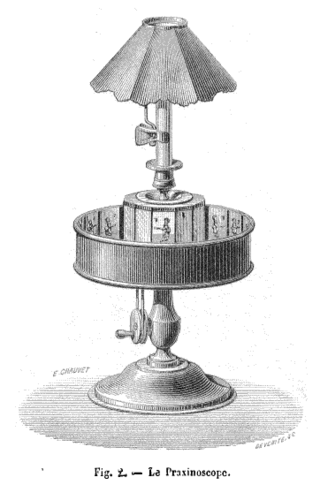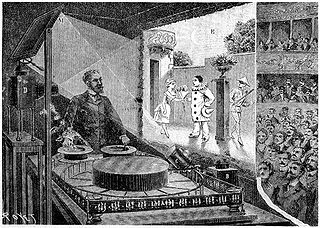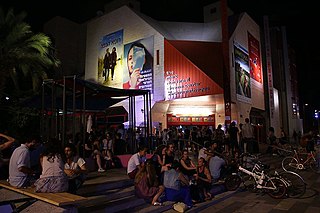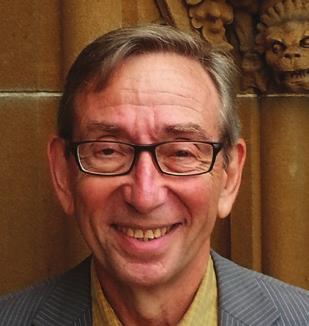
Charles-Émile Reynaud was a French inventor, responsible for the praxinoscope and was responsible for the first projected animated films. His Pantomimes Lumineuses premiered on 28 October 1892 in Paris. His Théâtre Optique film system, patented in 1888, is also notable as the first known instance of film perforations being used. The performances predated Auguste and Louis Lumière's first paid public screening of the cinematographe on 26 December 1895, often seen as the birth of cinema.

The praxinoscope was an animation device, the successor to the zoetrope. It was invented in France in 1877 by Charles-Émile Reynaud. Like the zoetrope, it used a strip of pictures placed around the inner surface of a spinning cylinder. The praxinoscope improved on the zoetrope by replacing its narrow viewing slits with an inner circle of mirrors, placed so that the reflections of the pictures appeared more or less stationary in position as the wheel turned. Someone looking in the mirrors would therefore see a rapid succession of images producing the illusion of motion, with a brighter and less distorted picture than the zoetrope offered.

The Annie Awards are accolades which the Los Angeles branch of the International Animated Film Association, ASIFA-Hollywood, has presented each year since 1972 to recognize excellence in animation shown in American cinema and television. Originally designed to celebrate lifetime or career contributions to animation, the award has been given to individual works since 1992.

ASIFA-Hollywood, an American non-profit organization in Los Angeles, California, is a branch member of the International Animated Film Association. Its purpose is to promote the art of film animation in a variety of ways, including its own archive and an annual awards presentation, the Annie Awards. It is also known as the International Animated Film Society.

The Animation Workshop is an animation school housed in the former military barracks in Viborg, Denmark. It is a part of VIA University College's School of Business, Technology and Creative Industries. Since the late 1980s, The Animation Workshop has educated and trained animators for the Danish as well as the international animation, computer game and visual effects industry. The Animation Workshop has a strong international network of artists, professionals, companies, funding institutions and partner schools. Teachers and students come from Denmark and the rest of the world, and all classes are conducted in English.
The International Animation Festival Hiroshima is a biennial animation festival hosted in Hiroshima, Japan. The festival was founded in 1985 by Association International du Film d'Animation or ASIFA as International Animation Festival for the World Peace. The city of Hiroshima was one of the sites of nuclear bombings in 1945 at the end of World War II and it was chosen to inspire thoughts of unity through the arts. The festival was considered one of the most respected animated film festival, along with Annecy International Animated Film Festival, Ottawa International Animation Festival, and Zagreb World Festival of Animated Films.

The Théâtre Optique is an animated moving picture system invented by Émile Reynaud and patented in 1888. From 28 October 1892 to March 1900 Reynaud gave over 12,800 shows to a total of over 500,000 visitors at the Musée Grévin in Paris. His Pantomimes Lumineuses series of animated films include Pauvre Pierrot and Autour d'une cabine. Reynaud's Théâtre Optique predated Auguste and Louis Lumière's first commercial, public screening of the cinematograph on 28 December 1895, which has long been seen as the birth of film.
The International Animated Film Association is an international non-profit organization founded in 1960 in Annecy, France, well-known animation artists, including Canadian animator Norman McLaren. There are now more than 30 chapters of the Association located in many countries of the world.
The International Tournée of Animation was an annual touring program of animated films that started in 1965 as The First Festival of Animated Film with each selected and assembled from films from many countries around the world and which existed from the 1970s to the 1980s-90s.
Prescott J. Wright was best known as the longtime producer and film distributor of the annual touring programs of animated films from around the world known as the International Tournée of Animation. In addition, he was one of the founding directors of the Ottawa International Animated Film Festival in Canada, which began in 1976 and which is now held annually, as well as being instrumental in fostering the art of animated films throughout his working life.
The history of Iranian animation, which began in its modern form in the mid 20th century in Iran, can also be traced back to the Bronze Age.

World Festival of Animated Film Zagreb, best known as Animafest Zagreb, is a film festival entirely dedicated to animated film held annually in Zagreb, Croatia. Initiated by the International Animated Film Association (ASIFA), the event was established in 1972. Animafest is the second oldest animation festival in the World, after the Annecy International Animated Film Festival.
The Indian Animation Industry encompasses traditional 2D animation, 3D animation and visual effects for feature films. In 1956, Disney Studios animator Clair Weeks, who had worked on Bambi, was invited to Films Division of India in Mumbai to establish and train the country's first animation studio as part of the American technical co-operation mission. He trained a core group of Indian animators, whose first production was a film called The Banyan Deer (1957). Veteran animator Ram Mohan started his career at Films Division's Cartoon Unit.
William Charles Littlejohn was an American animator and union organizer. Littlejohn worked on animated shorts and features in the 1930s through to the 1990s. His notable works include the Tom and Jerry shorts, Peanuts television specials, the Oscar-winning short, The Hole (1962), and the Oscar-nominated A Doonesbury Special (1977). He was inducted into the Cartoon Hall of Fame and received the Winsor McCay Award and garnered lifetime achievement awards from the Annie Awards and the UCLA Film and Television Archive. Director Michael Sporn has called Littlejohn "an animation 'God'."

The Tel Aviv International Student Film Festival is the largest of its kind in the world and is considered one of the most important in its field. The film festival hosts hundreds of students, lecturers and guests of honor from the world's leading film industry in Tel Aviv, for a week of screenings and cultural events. Hundreds of films, premieres, cinematic events, workshops, conferences and special projects are held, inviting thousands of visitors to the Tel Aviv Cinematheque halls every day. Since 2013, it has been held once a year, in June, in Tel Aviv.
Peć is a city located at the western part of the Kosovo. Numerous cultural activities and events are organized each year in the city.
Animasyros is an international animation festival and forum. Since 2008 the festival takes place in the capital of Cyclades, Hermoupolis of Syros, and includes animation movies screenings, special tributes to international festivals, professional forum with the participation of distinguished Greek and foreign creators and professionals, workshops for students and children, the applied follow-up workshop “making of”, parties and other parallel events.
Dancing Diablo is an animation, advertising, and media company based in New York.
The Emile Awards is an annual ceremony celebrating excellence and diversity in the European animation film industry. The awards consist of 18 trophies for outstanding accomplishment in European animation, as well as the Lotte Reiniger Lifetime Achievement Award, which is awarded to "an individual in recognition of their lifetime contribution to the art of animation exhibited by an outstanding contribution to excellence in animation." The Emile Awards are presented by the European Animation Awards Association, which was founded in 2015 under the name "European Animation Pride Awards".

Alan Robert Cholodenko is an American-Australian scholar, film and animation theorist. His most recognized work are two of the earliest publications in the field of animation studies, namely The Illusion of Life: Essays on Animation, published in 1991, and The Illusion of Life II: More Essays on Animation, published in 2007. His work in the field was reviewed by animation and film scholars Richard Leskosky and Vivian Sobchack. Cholodenko's work has been featured in such publications as the International Journal of Baudrillard Studies and Animation: An Interdisciplinary Journal, as well as in the anthologies Animating Film Theory;Erasure: The Spectre of Cultural Memory; and Animation: Critical and Primary Sources.








